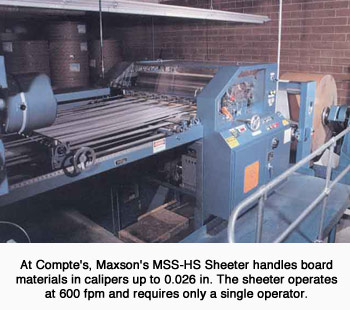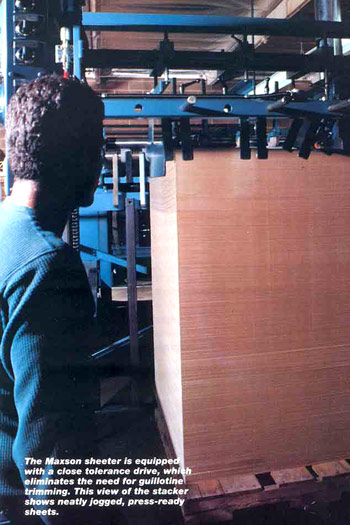The need for greater quality control was central to one folding carton manufacturer’s decision to bring sheeting in-house. As a result of this move, Compte’s Inc., can now offer their product faster and at a more competitive price, while also maintaining a high standard of quality.
Located in Pico Rivera, Calif., Compte’s was founded in 1957. While this family-owned company originally started as a die-cutting operation, Compte’s operations now include all aspects of folding carton production. The company’s finishing equipment includes two Bobst die-cutters, a five-color Komori lithographic printing press, and two International Paper Box Machine folder/gluers.
 Compte’s employs 34 people and serves a customer base located on the west coast. The company’s product line includes folding cartons for health and beauty aids, pharmaceuticals, and electronic equipment. Compte’s also manufactures promotional displays.
Compte’s employs 34 people and serves a customer base located on the west coast. The company’s product line includes folding cartons for health and beauty aids, pharmaceuticals, and electronic equipment. Compte’s also manufactures promotional displays.
Until recently, the firm relied on an outside source to sheets its stock. According to company president Orin Compte, this arrangement served their needs for many years, but it was not without some disadvantages. On occasion, the quality of the sheeted stock was not acceptable, causing printing-related defects such as hickies, as well as excessive downtime for press wash-ups. Another drawback was that deliveries of sheeted stock lengthened lead times an additional week.
Compte realized that by bringing sheeting in-house, he could exercise greater control over the quality of his product. Additional benefits of in-house sheeting included eliminating sheeting up charges of $125/ton and the ability to turn orders around more quickly. Compte notes that prompt service can often be the deciding factor when competing for an order. “Time is money, and delivery dates are customers.”
Investigating quality
During the company’s investigation of sheeting equipment, a single requirement was emphasized-quality. ” Because we are a quality operation, the most important criterion for us was achieving a clean cut,” says Compte. With this demand in mind, a high-speed

MSS-HS precision sheeter from Maxson was chosen.
The Maxson sheeter handles a wide range of board materials in calipers up to 0.026 in. at Compte’s. The company sheets SBS, SUS, CCNB, and bending chipboard grades supplied by the leading companies. “We used to have hickies caused by dust on the sheeted stock, but with the Maxson, we get a clean cut. The quality of the sheets is much better and we have fewer headaches at the press,” explains Compte.
The new sheeter operates at speeds up to 600 fpm and requires only a single operator. Compact in design, the unit requires little floor space. During installation, Maxson provided a field erector to optimize the machine’s performance during startup. “The sheeter startup required minimal operator training,” recalls Compte.
To speed setup during roll changes, Compte selected a shaftless self-loading back stand. This design eliminates the need for an overhead hoist when loading rolls. As the operator moves the roll into place, the back stand cradles the roll and lifts it into position. A roll change is complete in less than five minutes, vs. 20 minutes with a shaft-type design.
The sheeter is equipped with a close tolerance drive that provides press-ready sheets. No guillotine trimming is required. Compte estimates his sheeter waste to be around 1 percent, representing a real savings in paper cost over the previous method. “Our waste percentage ranged from 3 to 5 percent when our rolls were sheeted by an outside source,” he says.
The ability to sheet in-house places Compte’s in a solid position top seek new markets. One opportunity for growth that is presenting itself is contract sheeting. “The new sheeter has really been a blessing in disguise. It’s offered us greater flexibility, as well as allowing us to secure orders we might not have gotten in the past,” More importantly, however, is that Compte’s need for quality has been satisfied. Because clean sheets are a prerequisite for a quality printed piece, Compte’s now has the ability to monitor production each step of the way. “With the new sheeter, we now only have one-tenth the problems that we used to have. It has definitely given us the quality we demand in our product,” Orin Compte says in summary.
Reprinted from Converting, September 1991






